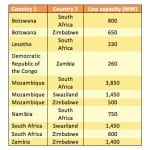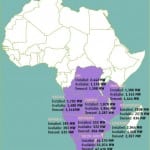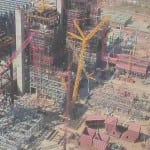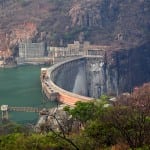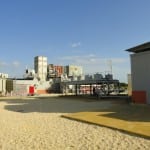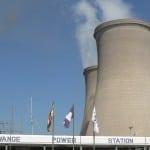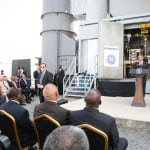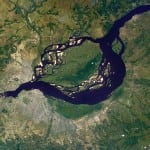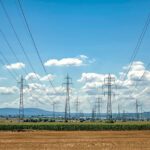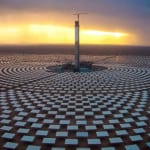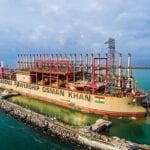Power produced by South Africa represents 40% of Africa’s total—yet that country is facing a crippling supply shortfall. Emergencies are offset with imports from its neighbors in southern Africa, some of which are electricity poor, and others that are latent supply giants.
“Power Africa,” the recently announced U.S. initiative that earmarks $7 billion in public funds and $9 billion in private funds over the next five years to double access to electricity in sub-Saharan Africa, echoes the Sustainable Energy for All initiative launched by the United Nation’s secretary general less than a year before. But though the funding is much needed, it represents a tiny fraction of the immense $280 billion required to furnish the region’s 600 million people with access to electricity by 2030.
It is not that Africa lacks the resources: The continent, and particularly its southern region, is wealthy in mineral deposits, including unexploited coal, natural gas, and oil. Water systems vary from one country to another, but the continent is home to thousands of miles of waterways, and it has a feasible hydroelectric potential of 1,750,000 GWh/year, only 4.3% of which has been exploited. It has high solar, wind, and biomass potential. Yet, while its population is growing, the region as a whole is crippled by a general lack of generation facilities and incomplete interconnection grids.
Today, 75% of Africa’s generation capacity is concentrated in just five countries: South Africa, Morocco, Egypt, Libya, and Algeria. Excluding South Africa, the total power generation capacity of the 48 sub-Saharan African countries stands at 28 GW, which is equal to that of Argentina. Meanwhile, the average cost of electricity stands at $0.18/kW—almost double that of other developing nations.
Pooling Resources to Make Progress
To improve regional electricity integration and cooperation through grid interconnection, a number of African regions have adopted power pools. Southern Africa, for example, is divided into a hydro-rich northern region encapsulating the Democratic Republic of Congo, Tanzania, Angola, Zambia, Zimbabwe, Malawi, and Mozambique and a thermal-rich southern region, comprising Namibia, Botswana, South Africa, Lesotho, and Swaziland (Table 1).
In 1995, the ministers responsible for energy in the Southern African Development Community (SADC) signed an intergovernmental memorandum of understanding that led to the creation of the Southern African Power Pool (SAPP)—the first organization of its kind in sub-Saharan Africa. Financed by a number of international entities, SAPP continues its mission to optimize the use of available energy resources in the region and support each of its 12 member countries in the event of energy emergencies. Its membership is composed of 16 utilities, independent transmission companies, and independent power producers representing Angola, Botswana, Democratic Republic of Congo, Lesotho, Malawi, Mozambique, Namibia, South Africa, Swaziland, Tanzania, Zambia, and Zimbabwe.
Table 1. Existing transmission infrastructure summary in southern Africa and new cross-border transmission projects. Southern African countries, which are members of a regional power pool, face a number of infrastructure challenges. This table summarizes existing transmission lines. At least three major new lines are in the pipeline: The 600-MW Zizabona, which is due to become operational in 2015, the 1,500-MW Westcor line, expected to be opened in 2020, and another 1,500-MW 765 kV line that will also start operations in 2020. Source: IRENA
Perhaps the most glaring problem faced by the region is that it does not have enough supply to meet demand. Some estimates put the deficit at 2 GW daily (Figure 1). Plans are under way in each country to build an additional 6.5 GW of capacity between now and 2016, but the region is seeking short-term solutions to addressing the shortfall.
1. In short supply. The 1995-created Southern Africa Power Pool (SAPP) encompasses 12 countries (in purple) with a total population of 280 million. In total, the region has an installed generation capacity of 56 GW and a peak demand of 54 GW—but only 51 GW of generation is currently available. This graphic shows supply deficits in some of the pool’s most prominent members. Source: SAPP
SAPP has recently proposed migrating from a cooperative to a competitive pool—though it notes that implementing a competitive market is increasingly difficult as the region runs out of generation reserve capacity, making it difficult for members to rely on short-term markets. The exchange of power within southern Africa has traditionally been handled through long-term bilateral contracts, which continue to be the preferred method. In addition to utility bilaterals, there is the SAPP short-term energy market (STEM), post-STEM, and day-ahead market. SAPP hopes to add an ancillary service balancing market and financial markets but notes those services will require radical changes.
The group has urged members to embrace the principles of cost-reflective tariffs to address the problem of diminishing generation surplus capacity. The operation of a regional transmission grid will also require “adherence to operational discipline” and good metering and telecommunication systems, it says.
But it could take much more, as was underscored in an interesting executive exchange last year involving meetings between representatives from SAPP markets and the U.S. Federal Energy Regulatory Commission, PJM Interconnection (PJM), the New York Independent System Operator (NYISO), the North American Electric Reliability Corp., and Southern Co. subsidiaries Georgia Power and Alabama Power. The U.S. has mostly moved from the traditional power pool model to one that relies on independent system operators (ISOs) for its power exchange. It was highlighted that the core difference between the North American and southern African structures is that in the U.S., the majority of utilities have given over the management of their transmission lines to the ISOs to allow them to better optimize transmission in a way that benefits the region. In SAPP, individual utility entities still control their own lines—and most are resistant to relinquishing them to an independent operator, citing, for one, the loss of ability to handle emergencies within their own countries. At the meetings, PJM and NYISO both stressed that trust and transparency were crucial to ensure reliability, conduct regional planning, and operate the energy market.
Following is a survey of the electricity woes and wonders of some of SAPP’s key players.
South Africa’s Power Emergency
South Africa’s wholly state-owned electricity utility Eskom has been under fire since rolling blackouts hit the country and its grid nearly collapsed in January 2008 (see “Whistling in the Dark: Inside South Africa’s Power Crisis” in POWER’s November 2008 issue)—spotlighting the country’s critical power supply woes and hinting at a perennial electricity crisis that will last until at least several major coal-fired plants come online at the end of this year. The utility that supplies about 95% of South Africa’s power (and more than 40% of Africa’s total output) produces about 85% of its power from coal, 5.8% from natural gas, and 4.4% from nuclear—and for half a decade now, it has implemented load shedding (or narrowly dodged it) as its reserve margins dip precariously.
In March 2013, the country’s demand outstripped its available supply of 41 GW after the only nuclear plant—Koeberg in Cape Town—tripped, floods in Mozambique brought down one of two supply lines from the Cahora Bassa hydropower plant, and the sweltering summer heat prompted “volatile” generation from coal-fired power plants in the north that had been prevented from planned down time and maintenance by soaring demand. Then, in November 2013, Eskom declared a power emergency, reducing power to key industrial customers—without compensation for loss of production, as stipulated in agreements—to reduce consumption and ease pressure on the grid. Power supplies remained tight for two weeks after the utility’s aging generating units tripped while others were shut down for maintenance. The 2008 crisis forced mines, factories, and aluminum smelters to shut down for days, costing the country’s economy billions of dollars in lost output and prompting a 20% sell-off of in the rand and a large volume of bond outflows.
Plans call for the addition of 17.1 GW of new generation by March 2018, of which 5.8 GW has already been commissioned. Projects include returning the 1-GW Komati, the 1.5-GW Camden, and the 1.18-GW Grootvlei plants from mothball status. Meanwhile, the Medupi and Kusile power stations, massive 4.8-GW coal-fired plants, are nearing completion and should come online between 2014 and 2018 (Figure 2). Other projects include the 100-MW Sere wind power plant, a 100-MW pilot concentrated solar power plant, and an increase of peaking capacity from the 1.3-GW Ankerlig, 746-MW Gourikwa, and 1.3-GW Ingula plants. Then, at least 60 “grid-strengthening” projects spanning 4,700 kilometers are under way.
2. A coal heavyweight. South Africa’s state-owned power generator Eskom plans to commission in the second half of 2014 the first of six 794-MW generating units (totaling 4.8 GW) at its Medupi coal-fired power station under construction in Lephalale in Limpopo. The plant will be the first in the nation to use supercritical technology. The first unit of Eskom’s coal-fired 4.8-MW Kusile power station, which it is building in Mpumalanga, is scheduled to go online in December 2014. The Kusile plant will be the first in the country to use wet flue gas desulfurization. Courtesy: Eskom
Mozambique: A Latent Supply Giant
One of sub-Saharan Africa’s largest generators and exporters of electricity, Mozambique is strategically positioned and has adequate infrastructure to meet shortfalls in energy supply in the SAPP. The country is also extraordinarily rich in resources: It has three large coal deposits at Moatize-Minjova, Senangoe, and Mucanha-Vuzi in Tete Province with reserves estimated at more than six billion tons. Meanwhile, in 2012, four of the five largest oil and gas discoveries in the world were made in offshore Mozambique.
Today the country produces the bulk of its power with the 2,075-MW Cahora Bassa hydroelectric project (Figure 3)—the largest scheme in southern Africa—which straddles a tributary of the Zambezi river system. However, Mozambique has embarked on ambitions to accelerate electrification of the country. It has much progress to make, but it is making headway: Compared to 2005, when just 55 districts were electrified (and only 8% of the population had electricity access), as of 2012, 110 districts were covered and about 23% of its citizens have electricity access.
3. Harnessing the mighty Zambezi. The Zambezi River, which rises from marsh in northwest Zambia, is the fourth-longest river in Africa. Two main sources of hydropower harvest the river’s flow: the 1.3-GW Kariba Dam, which provides power to Zambia and Zimbabwe, and the 2-GW Cahora Bassa Dam in Mozambique, shown here. Courtesy: Rich Beilfuss
To this end, the government is looking to add its first coal-fired power plant, the Ncondezi Project area in the Tete Province, which will be developed in phases. The first 300-MW integrated mine and power plant, expected to be expanded to 1,800 MW, will use circulating fluidized bed technology; it is slated to come online in 2018. India’s Jindal Steel and Power has also proposed a 2,640-MW coal plant in Tete province, and Brazil’s Vale and Rio Tinto are separately planning 2,000-MW plants at Moatize and Benga. At the same time, a 1,245-MW expansion of Cahora Bassa is in the works, and the government has opened opportunities for the development of gas-fired plants from 200 MW to 1 GW in the north for domestic use and to serve the SAPP. Building new transmission links will be essential to the progress of all these projects, experts say.
Mozambique’s electricity sector is overseen by the Ministry of Energy, but the bulk of its generation, transmission, and distribution is undertaken by Electricidade de Moçambique (EDM), a 100% state-owned company. Other major entities include Hidroeléctrica de Cahora Bassa, which oversees Cahora Bassa plant but is 92.5% owned by the government (the remainder, 7.5% belongs to Portugal’s Redes Energéticas Nacionais).
Slow Progress for Shortage-Stricken Namibia
Namibia’s small power sector is characterized by a total peak demand of about 511 MW, of which 64% is met by imported power, mostly from South Africa and Zambia. As a number of power purchase agreements are set to expire, however, and its mining sector thrives, the country estimates it will suffer a power deficit of about 430 MW by 2015.
Namibia’s Vision 2030 policy document calls for self-sufficiency by 2030, and state-owned utility NamPower has attempted to bridge the coming deficit by stimulating involvement of independent power producers with a conducive investment environment (rather than financial incentives). About 710 MW of new projects are in the pipeline, including the 600-MW Kudu Combined Cycle Gas Turbine plant, which is slated to come online in 2018, the 30-MW GreeNam, and the 80-MW Arandis diesel project. The Kudu project will use gas from an offshore field jointly owned by Tullow Oil, Itochu Corp., and Namcor, Namibia’s state-owned petroleum company. Observers point out, however, that the Kudu gas power project has been delayed numerous times, owing largely to issues with development of the offshore gas field. NamPower, meanwhile, is seeking equity participation to offset nearly half of the estimated project $1.1 billion cost.
Underscoring the urgency for new power supplies in a country that is characterized by broad expanses of hyper-arid gravel plains and dunes of the Namib and Kalahari Deserts is a drought that gripped the nation in December. The fall in water levels of the Ruacana River resulted in erratic power generation—but pleas for assistance from Eskom were shunned chiefly because of South Africa’s own chronic supply issues. Nampower is also reportedly assessing the potential to invest in two thermal power stations in Zimbabwe (in Harare and Bulawayo) in return for guaranteed supplies. That deal that could replace a 2007 deal in which NamPower advanced Zimbabwean utility ZESA $40 million to refurbish four units at the coal-fired Hwange Power Station in return for a guaranteed supply of 150 MW for five years.
NamPower, which holds a monopoly over the transmission system, also acts as the bulk purchaser of power. The sector is regulated by the Electricity Control Board, which is also responsible for promoting private sector investment.
Botswana Relies on Imports from Neighbors
Though endowed with sizable coal reserves and a lucrative diamond mining sector, land-locked Botswana’s reliance on power imports gradually increased from 51% in 2000 to 94% in 2012. Electricity demand growth from increasing electrification (more than 70% of the population has access), its mining sector’s needs, and the otherwise stable economy forced the country to build the 600-MW Morupule B Power Station coal-fired power plant to avert a power crisis.
Otherwise, beyond electricity that is supplied by the state-owned Botswana Power Corp. (BPC), the remainder comes from diesel generators. Observers note that Botswana urgently needs to increase its power supply, and a number of projects are in the pipeline, including two 300-MW greenfield coal projects. India’s Jindal Steel and Power has expressed interest in reviving plans to build the Mmamabula 3.6-GW power plant in central Botswana, a project that was scaled down in 2008 to 300 MW due to market issues.
Botswana, meanwhile, has been criticized for undertaking little meaningful reform of its power sector, despite its increasing imports. BPC is overseen by the Energy Affairs Division of the Ministry of Minerals, Energy, and Water Resources. In 2007, the government amended the energy supply act to facilitate the participation of IPPs, and there are plans to restructure the sector in accordance with the country’s membership in the SAPP.
Oil-Rich Angola Banks on Hydropower
Angola, Africa’s largest crude oil producer after Nigeria, has set the ambitious goal to increase its generating capacity from 1.8 GW now to 9 GW by 2025 to alleviate chronic and economically debilitating power shortages.
Angola is still recovering from a 27-year civil war, in which much infrastructure was destroyed, and only 30% of the country’s 21 million citizens have access to power, so it has outlined plans to build about 15 power plants and to pour $24 billion into its grid by 2017. So far, four plants along the Kwana River have been approved. These include the $3.9 billion 400-MW Lauca Dam, which is slated to be completed by 2017 and will be expanded to 2,069 MW by 2025. The $1.5 billion Cambembe 2 project envisions 380 MW of capacity by 2015, and it will be increased to 780 MW two years later. Another massive hydro plant, the 2,047-MW Caculo Cabaca project, may be started next year and completed within six years.
The country already relies on hydropower from the Cuanza, Catumbela, and Cunene Rivers for about 68% of its current electricity needs, but given its vast natural gas reserves, thermal generation will likely gain increasing importance over the next decade (Figure 4). In 2006, Angola began discussions with the International Atomic Energy Agency about developing a domestic nuclear power program, though details remain scarce. Among committed thermal plants is a natural gas power plant at Soyo near the mouth of the Congo River, a $1.6 billion project that will use four turbines for a capacity of 500 MW by 2015.
4. Filling the gap with gas. In 2012, global engineering firm Isolux Corsán delivered to Angola’s state-owned Empresa Nacional de Electricidade an open cycle power plant with two 35-MW gas turbines. The plant is located in the province of Cabinda. Courtesy: Isolux Corsán
Angola’s electricity sector is run almost exclusively by the state company Empresa Nacional de Electricidade (ENE), but some private companies in the oil and gas extractive industries have built power plants to run their operations. The national transmission system consists of three independent grids that provide electricity to different parts of the country. This year, the country will embark on restructuring of three state-owned electricity companies, giving them separate production, transmission, and distribution duties.
Zambia Prioritizes Power Sector Growth
Targeting an economic growth of 8% per year, but wary that that cannot be achieved with its current power supply situation, Zambia has embarked on energy infrastructure upgrades to meet increasing demand for electricity, chiefly by mines. Moreover, the country is positioning itself to increase power generation to its electricity-poor SADC neighbors—exports that could earn it an extra $2 million a month.
For one, the country has substantial unexploited reserves of coal, biomass, and renewables. Zambia’s current proven coal deposits, estimated to be about 80 million tons, are located in the Southern Province, but the country claims at least 700 million more tons are probable in the north. The country also has more than 80 hot springs associated with zones of major deep-seated fault and fracture systems—though these have remained untapped for geothermal power owing to large costs. Meanwhile, Zambia possesses 40% of southern Africa’s water resources. It is no wonder then that hydropower is the country’s most important electricity source, contributing to about 96% of its total installed capacity of 1,985 MW. But the country has not added any new plants to its generation portfolio in more than two decades.
Among projects in the pipeline are the 40-MW Kabompo Gorge Hydro project and a 300-MW coal power plant in Sinazongwe district. EMCO Energy Zambia is also vetting plans to build a 600-MW plant in the same area, and Konkola Copper Mines, Zambia’s biggest power consumer, is exploring for coal and could build a 250-MW power plant to reduce its own power costs.
The country’s electricity sector is dominated by three entities: state-owned utility ZESCO, the Copperbelt Energy Corp. (CEC), and the Lusemfwa Electricity Co. Amendments to the second schedule of the Zambia Development Agency Act have declared power generation a “priority sector” to reduce the cost of developing power plants and attract IPPs. That means, essentially, that building and operating power plants using various sources (including thermal and solar) will now qualify for tax concessions. However, CEC said in 2012 that power prices in the country will need to double to make it viable to build new generation capacity and end the supply shortage.
Zimbabwe’s Lethargic Investment Proves Costly
In Zimbabwe, which has been independent for a mere 33 years, crippling power shortages are rife, owing largely to a lack of investment in the sector due to what its major players deem are “uneconomical” tariffs. The country’s projected demand of more than 2.2 GW falls far behind its available capacity of 1.6 GW.
The country’s largest thermal power plant, the Hwange Power Station (Figure 5), has been operational for more than three decades—but it is the country’s youngest power plant and suffers routine outages partly due to neglected maintenance and overdue upgrades. National power utility ZESA says it needs $5 billion for recapitalization, and government directives to keep tariffs low have sent it nearly $1 billion in debt.
5. A forgotten power source. The 920-MW Hwange Thermal Power Station is Zimbabwe’s largest power plant. Since it was commissioned in 1987, the plant has suffered technical problems due to maintenance neglect and part replacement. Namibia in 2009 made a deal with ZESA Holdings, Zimbabwe’s national electricity company, to revive the plant in exchange for power. Meanwhile, Hatch is managing a 600-MW expansion of Zimbabwe’s Power Co.’s coal-fired plant, which could ease the country’s crippling power crisis. Completion of the expansion is expected in 2015. Courtesy: Hatch Goba
Meanwhile, the country has failed to attract more than a few IPPs, which feed only about 6 MW into the grid, even though the market has been opened to other players. A handful of other generators produce about 58 MW for their own consumption.
The 2013 national budget foresees that the power sector will grow by 1.9%—about 430 MW—driven by the repowering of the 90-MW Bulawayo and 50-MW Harare coal-fired power stations and the rehabilitation of Hwange. According to the Zimbabwe Energy Regulatory Authority, the country’s deficit could see an improvement after 2017, following the completion of a 600-MW expansion at Hwange and the culmination of expansion works that began last year to add 300 MW at the 750-MW Kariba South hydropower station.
Tanzania’s Power Future Hinges on Natural Gas Development
Only 18.4% of Tanzania’s citizens have access to electricity, and while it has 1,143 MW of available generating capacity, it needs 1,444 MW. Its power sector today suffers heavily from inefficiencies—across installed generating capacity, transmission, and distribution (Figure 6). Recent discoveries of recoverable natural gas reserves, estimated to be 33 trillion cubic feet—which could make the East African country the world’s third-largest gas exporter—could change the profile of the country’s power sector.
6. Making amends. The 112-MW Ubongo power plant had been shut down but was brought back online after Tanzania committed to make reforms in its energy sector. The plant features four General Electric LM-6000 aeroderivative gas turbines. U.S. President Barack Obama urged African governments to address the chronic shortage of power when he visited the plant in March 2013. Courtesy: Symbion
As in neighboring countries, Tanzania’s generation mix for the most part relies on hydropower, but it also relies on natural gas imports and expensive emergency short-term liquid fuel generators. Fuel imports, combined with vulnerability to drought (which recurred in 2010, 2011, and 2012) make its gross domestic product vulnerable. In its 25-year power sector master plan, the country’s government has called for a 6-GW increase in capacity, which will help exploit some of its domestic gas reserves, but the plan mostly focuses on developing more hydropower and some thermal generation in the near to medium term. Among hydro plants in the pipeline are the 2.1-GW Stiegler’s Gorge project and the 358-MW Ruhudji project. Major projects under development include Globeleq’s 180-MW gas plant, the government’s 200-MW Kiriwa coal-fired plant, and its 240-MW Kinyerezi gas-fired plant.
Experts point out that one outstanding issue involves the Tanzania Petroleum Development Corp.’s control of the supply of natural gas, which is abetted by a national policy that favors domestic use over exports. That poses a conflict of interest for international investors, who seek to exploit the country’s reserves for export purposes.
A number of renewable groups, meanwhile, note that Tanzania is endowed with high wind, solar, biomass, and geothermal resources. At least 50 potential sites have been identified as suitable for geothermal development, while two potential locations have been set for wind development.
The bulk of Tanzania’s generation and all its transmission and distribution are owned by the state-owned Tanzania Electric Supply Co. (TANESCO). The power sector is regulated by the Energy and Water Utility Regulatory Authority, which also regulates petroleum, natural gas, and water sectors.
DRC Banks on Inga Scheme
Located in the African Great Lakes region, the Democratic Republic of Congo (DRC) is the second-largest country in Africa after Algeria, and it has an immense hydropower potential of more than 100 GW. Even more impressively, about 44% of that total is concentrated at the single Inga site, about 150 km from the mouth of the mighty Congo River—the third-largest river in the world by volume of water discharged. It has frequently been suggested that the Congo’s high flow of 42,000 cubic meters, its regularity, and the series of rapids encountered at Inga make the site possibly the largest source of hydroelectric power in the world concentrated at one point. The DRC generates 100% of its installed 2,442 MW capacity through hydropower, but its available capacity is just 1,228 MW, and the country still has a paltry electrification rate of 9% and a power shortfall.
SAPP countries have taken note, as have international investors, of the DRC’s proposal to build Inga 3, a 4.8-GW hydropower plant, at the site starting in October 2015. The DRC hopes to make Inga 3 the first of eight massive units that would comprise the even more ambitious 40-GW Grand Inga project. Two existing dams—Inga 1 and Inga 2 (Figure 7)—have been operating on the Congo River for more than three decades, but they are dilapidated and underperform at around 50% of capacity. Internationally backed efforts to refurbish those plants are under way, but even these more modest projects have been plagued by years of delay (for more on the Inga plants, see Headway for Congo’s Long-Delayed 40-GW Inga Hydro Project in POWER’s December 2013 issue). If built, Inga 3 already has a buyer for 2.5 GW of its output in South Africa’s power-strapped Eskom.
7. A hydropower hub. This satellite view of the Malebo Pool of the Congo River shows two capital cities on opposite banks: Brazzaville (the Republic of Congo) on the north side and Kinsasha (the Democratic Republic of Congo) on the south side. The Inga dams are located 225 km southwest of Kinsasha at the site of the largest waterfall in the world by volume: the Inga Falls. Source: NASA
The project will be overseen by SNEL, the 100% state-owned utility that was converted into a commercial limited liability company by a 2008 liberalization act, and which has enjoyed a de facto monopoly in the production, transport, and distribution of power across the DRC due to the absence of any alternative electricity-producing source. SNEL currently has at least two projects under construction to address its low electrification rate: the 150-MW Chinese-backed Zongo 2 hydropower plant and the 63-MW Katende hydropower project, which it is building with Indian partners.
—Sonal Patel is a POWER associate editor (@sonalcpatel, @POWERmagazine)


